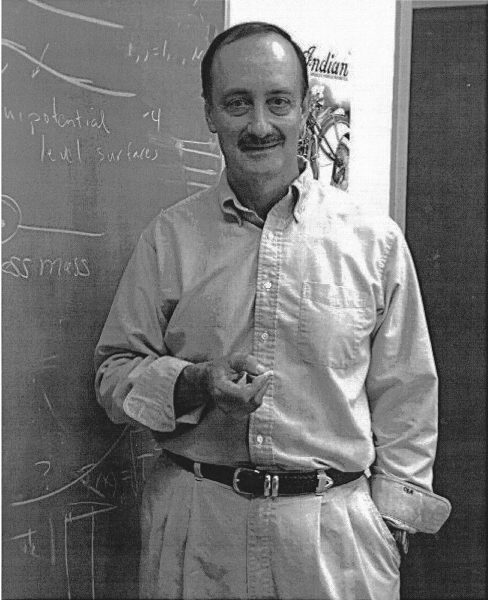Clark Wilson: Professor Emeritus
December 5, 2022
 By Kristin Phillips & Monica Kortsha
By Kristin Phillips & Monica Kortsha
It was the ocean — more specifically, an oceanographer’s slides illuminating a middle school wall six decades ago — that launched Clark Wilson into a career that included over 40 years of teaching and research, two rotations as chair of the Jackson School of Geosciences Department of Geological Sciences, and a three-year stint leading NASA’s Geodynamics Program in Washington, D.C.
“I saw nice pictures of tropical beaches and decided, ‘That’s it. That’s what I’m going to do,’” said Wilson. “This set me on a path studying physics at San Diego and landing an internship with Shell Oil as a geophysicist. I’d never heard of that field before — at the time there were almost no undergraduate programs in this field — but I found exploration geophysics very interesting.”
Wilson arrived at The University of Texas at Austin in 1976, the second geophysicist in a department loaded with field geologists, where a dissertation defense included a grilling about the properties of a rock placed in the center of the table. He soon forged relationships with other faculty members across the university who were leaders in their respective fields.
“I was very fortunate that the best people in the world were on campus, from satellite researchers in what became the Center for Space Research to colleagues in geotechnical engineering who were using seismic waves to determine the strength of soils for earthquake resistance,” said Wilson. “These two happy coincidences led to a lot of pleasant and interesting problems to work on throughout my career.”
And work he did. He published well over 200 research papers, many with graduate students and colleagues from across the campus. Some of his key research was in “geodesy”— a continuation of his dissertation research that used satellite data to measure variations in the Earth’s gravity and connect it to air and water distribution across the planet.
Geodesy is an essential part of modern geosciences research today. However, when it was getting started, it faced skepticism from some field geologists who were used to collecting their own measurements, said Byron Tapley, the director of the Center for Space Research and a longtime collaborator of Wilson’s.
Wilson’s research helped demonstrate the immense value of geodesy data to geoscientists — especially data collected by NASA’s Gravity Recovery and Climate Experiment (GRACE) satellite system.
Some of the highlights include identifying new areas in the Antarctic ice sheet that were losing mass, tracking changes in groundwater in California’s Central Valley, and connecting the shrinking of the Caspian Sea to rising temperatures.
“They were great projects that came out of great data,” Tapley said. “Those efforts were very important contributions to establishing GRACE measurements as essential for water- related studies,” he said.
Wilson’s close association with the Center for Space Research helped him become an expert in analyzing and applying data collected by GRACE, which Tapley oversaw from 2002 to 2017 as its principal investigator.
Wilson kept an office at the center, which is near UT’s J.J. Pickle Research Campus in north Austin, so he could collaborate with Tapley and others directly involved with GRACE operations. In turn, he served as a mentor for graduate students who relied on the data for their own research. Tapley said in a few instances, this led to engineering students deciding to study geosciences instead.
In the 1990s, Wilson moved his family temporarily to Washington, D.C., to head NASA’s Geodynamics Program, planning and funding international space missions. He remains a member of the GRACE mission, which is now on its second satellite system and is allowing scientists to continue to monitor the Earth’s gravitational field — and thereby measure the changes in the mass of ice sheets and determine the global water budget as the climate warms.
Wilson also helped bring important instruments to Texas, including the establishment of an important superconducting gravimeter at the McDonald Observatory, which measures subsurface fluids.
Tapley describes Wilson as quiet and thoughtful. He said that his studied approach to the instrumentation behind scientific data helped him make important strides in scientific research — and demonstrate the importance of geodesy to understanding the Earth’s changing character.
“These things come out of careful and solid work underpinning the research,” Tapley said. “I thoroughly enjoyed the interactions with Clark, and they defined a valued relationship.”
Wilson retired from teaching in 2021 as an emeritus professor, although he is not slowing down: If he is on campus, it’s a safe bet that he cycled the five miles to campus from his home on the other side of the Colorado River. He recently translated decades of teaching experience into a new textbook based on the fundamentals of data processing, he is supervising two graduate students, and he continues to co-author research papers. He does, perhaps, have a bit more time to devote to interests outside of the university. He rediscovered his passion for rowing six years ago and was part of the sport’s masters competition for a few years; he is part of the Rollingwood neighborhood’s utility commission; and he is, slowly and painstakingly, restoring two Jaguar Roadsters from the 1950s. Just ask him to show you the grease on his fingers.
Back to the Newsletter